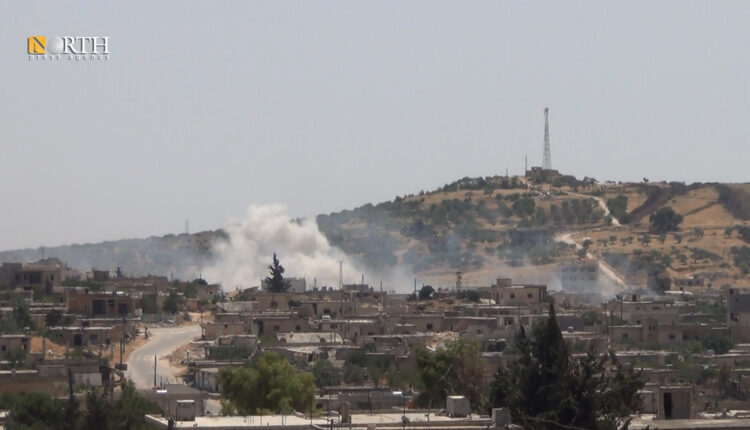Intensified clashes in northwest Syria erupt between Syrian Government forces and Turkish-backed militias
IDLIB, Syria (North Press) – Tensions sharply increased Friday throughout several areas in northwestern Syria, as heavy clashes and exchanges of artillery fire took place between the Syrian government forces and HTS, Hay’at Tahrir al-Sham, considered to be one of the most powerful Islamist factions, which formerly called itself Jabhat al-Nusra.
The fighting that swept the countryside of Idlib and Aleppo left numerous casualties on both sides, exacerbating concerns of a further destabilization of this already fragile area.
According to the opposition military sources, over 70 artillery shells and rockets hit HTS-controlled positions around Taqad, Kafr Amma, Al-Abzimo, Kafr Noran, and towns in the western countryside of Aleppo, launched by the Syrian government.
In turn, heavy shelling took place in southern Idlib, with over 60 shells hitting villages in the Jabal al-Zawiya region, which included al-Fatira, Sufuhun, Kafr Aweed, Kansafra, Maarbalit, Majdalia, and San.
According to a military source, the bombing killed three HTS fighters and wounded seven others close to the town of San in eastern Idlib. In addition, four HTS members were injured in Kafr Amma, west of Aleppo, representing the increasing toll taken on both personnel and infrastructure throughout these contested zones.
HTS Strikes Back with Counter-attacks
After the government’s bombardment, HTS troops waged their counterattacks on the Syrian government’s sites around the cities of Saraqib, Dadikh, Kafr Batikh in eastern Idlib, and pounded the 46th Regiment Base, western Aleppo.
In this counteroffensive, five Syrian soldiers were killed and a number of others were injured in the 46th Regiment Base according to the opposition sources.
HTS, whose roots are in al-Qaeda and has been branded a terrorist organization by several countries, has continued to hold sway over sizeable swathes of Idlib and its environs. It has frequently battled Syrian government forces, as well as other rival opposition factions from time to time, in the hopes of consolidating its dominance in northwestern Syria.
Russian Air Activity Ratchets Up Tensions
Adding to an already explosive atmosphere, Russian warplanes and reconnaissance aircraft carried out frequent flyovers over the skies of northwest Syria on Friday.
Although no airstrikes have been reported yet, such an intense manifestation in the air is widely perceived as flexing its muscles by Russia, a key ally of the Assad regime. The heavy surveillance and flyovers reflect Moscow’s close watch on the region, considering how critical it has been in the past in campaigns to support government offensives against opposition-held areas.
Russia’s military support has been a decisive factor in the survival of the Assad regime, while Russian engagement in northwest Syria has generally presaged an overall escalation of government forces. The recent spike in Russian air activity may indicate preparations for further escalation in Idlib and Aleppo, further adding to the concerns of local civilians and regional actors alike.
Background: Protracted Conflict in Syria’s Northwest
In fact, northwest Syria remains one of the last large strongholds of antigovernment forces, which include both HTS and various Turkish-backed factions constituting the wider opposition. The already complex dynamics of the conflict in this region are further complicated by the involvement of Turkey; Ankara has deployed forces in parts of northwest Syria to create a buffer zone against Kurdish-led forces (SDF) and to support certain opposition factions, many of which are in direct confrontation with HTS.
The Idlib region has since come under the tenuous arrangement for a ceasefire brokered by Russia and Turkey, dating from 2020. However, the ceasefire has been repeatedly broken by skirmishes and clashes. Despite the agreement, Syrian government forces, with Russian support, continue to pressure HTS and opposition forces to recapture the region. HTS, in turn, seeks to entrench itself and push back against any government encroachments, adding to the precarious stability of the region.
Humanitarian and Civilian Impact
As clashes escalate, the humanitarian repercussions continue to rise. Civilians in Idlib and western Aleppo have faced years of fighting, displacement, and economic challenges. The new incidents of violence put additional pressure on what is already a critical situation and where many depend on humanitarian help as a way to survive.
An estimated three million people reside in Northwest Syria, especially in Idlib, most of whom have been internally displaced from other areas in the country. The aid agencies have warned that any uptick in hostilities may lead to further displacement and strain on the already limited resources in this area. Infrastructure, including hospitals, schools, and marketplaces, is often caught in the crossfire, leaving communities prone to shortages in basic services.
The repeated breach of ceasefires has made it difficult for civilians to rebuild or maintain any semblance of normalcy. Meanwhile, humanitarian organizations face challenges accessing the region due to security risks and limited entry points, particularly given the presence of multiple warring factions and foreign actors with vested interests.

